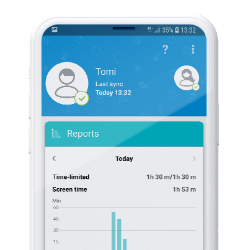How are my kids interacting with social media daily?
Trends are great until we fall for them.
Often our child’s digital safety starts even before they are born. Shared photos of an ultrasound, pregnancy updates, images of our kid’s bedroom decorations and that smiling potty training photo all create your child´s digital trail. This data is stored online for a very long time, making it virtually impossible to get rid of later in your child’s life.
So what exactly is a digital footprint, and what can you do to give your child the best start on their digital journey?
A digital footprint, or trail, is something we create through every action we take online. This information trail can grow in many ways. Whether it be sharing photos, commenting on a video, leaving a review or even online shopping, all this data is collected and stored. But not all data collected is the same. We have what are called passive and active digital footprints.
A digital footprint is virtually unavoidable in our day and age, or at least very hard to escape (one would never have to use a device connected to the internet). However, you can follow a few rules to make your child´s digital and offline future a bit safer.
1. Consider the embarrassment factor. These are things you should consider before posting about your child. Experts agree that three main factors determine whether a post is appropriate: Content. Comments. Coverage. Ask yourself, is this potty-training photo appropriate to share with strangers online? Is this comment on my child´s weight okay to say out loud in a public place? How will my child feel about me posting 30 photos of them in a few years’ time?
2. Ask permission. From a young age, teach your kids that asking permission to post about other people online is a must. And since your kid is too young to give you permission, think twice before uploading something online that they might not be comfortable with in the future (such as a baby tantrum video). They’ll thank you later.
3. Privacy. Ensure your accounts are private and that only people you trust are in your friends list or among your followers. By not having a public account, you eliminate a lot of the risk of misuse and alteration of your child’s photos.
4. Talk about online safety and data collection. Explain to your child what it means to lead a life accompanied by the internet. Talk to them about privacy and safety.
By taking these simple steps, you are not only protecting your children online but teaching them about proper online etiquette and healthy boundaries from a young age proper online etiquette and healthy boundaries. You, after all, are their gateway into a healthy relationship with themselves and the online world. One day they will thank you for it as they become more responsible internet users. And most importantly, make sure you have an open relationship with your children so they feel safe and free to come to you, ask questions and voice concerns on anything online and offline.


With ESET Parental Control for Android
TRY FREE FOR 30 DAYSTrends are great until we fall for them.
In our present digital age, where social media platforms are a hub for connection, it's crucial to understand the implications of oversharing, particularly for our kids.
By sharing more we can prevent oversharing